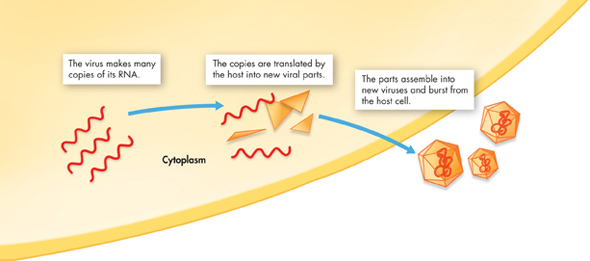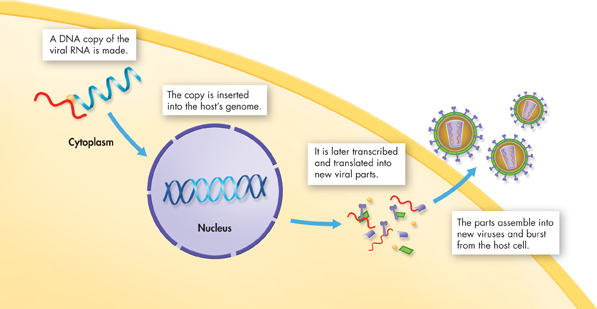
FIGURE 20–4 Common Cold Infection Mechanism Once the cold virus has penetrated the host's cells, it uses the host's cellular machinery to replicate itself.
dA Closer Look at Two RNA Viruses About 70 percent of viruses contain RNA rather than DNA. In humans, RNA viruses cause a wide range of infections, from relatively mild colds to severe cases of AIDS. Certain kinds of cancer also begin with an infection by viral RNA.
▸ The Common Cold What happens when you get a cold? Cold viruses attack with a very simple, fast-acting infection. A capsid settles on a cell, typically in the host's nose, and is brought inside, where a viral protein makes many new copies of the viral RNA. Meanwhile, the host cell's ribosomes mistake the viral RNA for the host's own mRNA and translate it into capsids and other viral proteins. The new capsids assemble around the viral RNA copies, and within 8 hours, the host cell releases hundreds of new virus particles to infect other cells.
▸ HIV The deadly disease called acquired immune deficiency syndrome (AIDS) is caused by an RNA virus called human immunodeficiency virus (HIV). HIV belongs to a group of RNA viruses that are called retroviruses. The genetic information of a retrovirus is copied from RNA to DNA instead of from DNA to RNA.
When a retrovirus infects a cell, it makes a DNA copy of its RNA, which inserts into the DNA of the host cell. Retroviral infections are similar to lysogenic infections of bacteria. Much like a prophage in a bacterial host, the viral DNA may remain inactive for many cell cycles before making new virus particles and damaging the cells of the host's immune system. Once activated, it begins to destroy the very system of the body that would normally fight infection.

FIGURE 20–5 HIV Infection Mechanism In contrast to the cold virus, a retrovirus such as HIV makes a DNA copy of itself that inserts into the host's DNA. There, it may remain inactive for many cell cycles.
dTable of Contents
- Formulas and Equations
- Applying Formulas and Equations
- Mean, Median, and Mode
- Estimation
- Using Measurements in Calculations
- Effects of Measurement Errors
- Accuracy
- Precision
- Comparing Accuracy and Precision
- Significant Figures
- Calculating With Significant Figures
- Scientific Notation
- Calculating With Scientific Notation
- Dimensional Analysis
- Applying Dimensional Analysis




